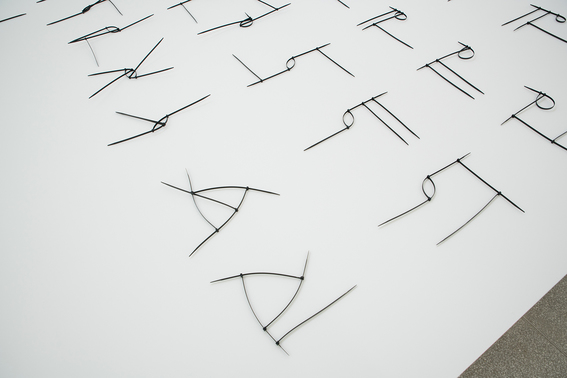-
From Current Issue
-
- Editor’s Letter Fire in the Heart
- Reviews I Gusti Ayu Kadek Murniasih
- Reviews 11th Seoul Mediacity Biennale: “One Escape at a Time”
- Dispatch Networked China
- One on One Monira Al Qadiri on Yukio Mishima
- Essays The rise of independent art spaces in pandemic-era Shanghai
- Features Tuan Andrew Nguyen
- Table of Contents
- Web Exclusives
- Archive
- Subscribe

R
E
V N
E
X
T
For his third solo show at Shanghai’s Vanguard Gallery, Liao Fei lodged a single large work in the main gallery while, nearby, across a bridge between two former textile mill buildings, other works were spread out in a larger venue at 0 Art Center.
The second location showed a bewildering number of works, comprising playful sculptures and drawings in pastel colours. In the exhibition’s collaterial material, “12 propositions”—such as “to shift the geometric shapes by their equal surface using construction with ruler and compasses”—classified different groups of works. The objects themselves defied the implied aesthetic rigor of these statements, as Liao utilized ubiquitous materials such as cable ties, marker pens and other hardware store items to create them.
Liao poses as a conceptualist, but the incursion of everyday bric-a-brac frustrates his efforts to achieve purity. His strategic purpose is to interpolate radically divergent ways of understanding the world. The exhibition’s title referenced the 16th century French philosopher René Descartes. The works integrated Descartes’ conception of matter and essence as a duality, with the manifold view of essence in Buddhist thought. To unite the two modes of thought is a wild ambition. It is not surprising that the resulting hybrid works looked provisional and sometimes absurd.
The presentation included a long research table spread with a curious arrangement of small sculptures, including Permutation Generation, Segmentation and Heteromorphism (all 2017). For these works, sheets of paper and graph paper were folded, creased into triangles, colored with crayons, and divided. Also installed on the table were Res Extensa Sculpture No. 1 to 9 (all 2017), made from marble, concrete and strips of wood, and strapped together with cable ties. These modest works set out to neatly visualize the proofs of mathematical propositions, but ultimately they fail, as unanticipated complexities make them untidy and inconclusive. They are études for similarly crafted larger works in the show, which serve to amplify these same difficulties.
A wall drawing titled Infinite, Natural Topology No. 1 (2017) also demonstrated this mode of persistence in the face of futility. In this work, two rows of modules begin with a set of two squares, stacked on top of each other and bisected by a diagonal line. Read left to right, each consecutive set of squares thereafter is an expansion of the last, and with every new combination the angle of the diagonal line is closer to being horizontal, but it will never be level, unless there are an infinite number of squares in the series. The gesture revealed an optimism—the belief that horizontality can be achieved by repeated action.
One-way Sculpture No. 1 – No. 4 (2017) was installed in the center of the space. The work plays with concatenation as well, this time with the promise of infinite diversity. Different variations of black cable ties were laid out on a large sloping platform, illustrating the combinations of two, three and four of these items at a time. Although there are hundreds of possible permutations, Liao reveals only a few dozen variations in this work, choosing to instead demonstrate the haptic act of joining the nylon strips together. An earlier work, Vehicle-2 (2015), which was parked in a corner of the gallery, is similarly pointless in its mathematical conjectures. As two sets of large and small wheels were used, Liao compensates for the irregularity with a warped board to form a working “vehicle,” the result of which looked ridiculous, like a wonky, oversized skateboard.
Res Extensa (2018) was monumental in size compared with the works at 0 Art Center. The work filled, or rather blockaded, Vanguard Gallery. Except for a vestibule area, two interlocking volumes occupied the entire space. This left an inaccessible but open plateau just above eye level. A narrow channel, about the width of a fist, penetrated the volumes. Its path, bisecting the space, was discernable only by craning one’s head above this surface. Requiring the audience to be active in both mind and body to explore the spatiality of their surroundings, the work discusses the philosophical principle of “aletheia,” where truth is an act of disclosure. Using only ordinary materials, Liao has gone to outrageous lengths to make the abstruse details of philosophical rumination tangible, and to celebrate the connection between the mundane objects of daily life and the abstract ideas of Western philosophy.
Liao Fei’s “Res Extensa” is on view at Vanguard Gallery, Shanghai, until March 31st, 2018.
To read more of ArtAsiaPacific’s articles, visit our Digital Library.









